Are you planning for your upcoming embroidery project and wondering which are the best hand embroidery thread to select from, then you are in right place. Embroidery is not just about neat and beautiful design it is also about the type of thread used for creating that design. If you are creating embroidery for hobby or commercial purposes, you will need the best type of thread to create a masterpiece. The selection of good embroidery thread is very important as all of your time and effort depends on it.
In this article, you will find detail about different types of embroidery threads and things to consider while choosing the best thread for your embroidery project. But trying and experimenting with different types of threads can give you an idea about the colors and textures, which can add a new charm to your designs.
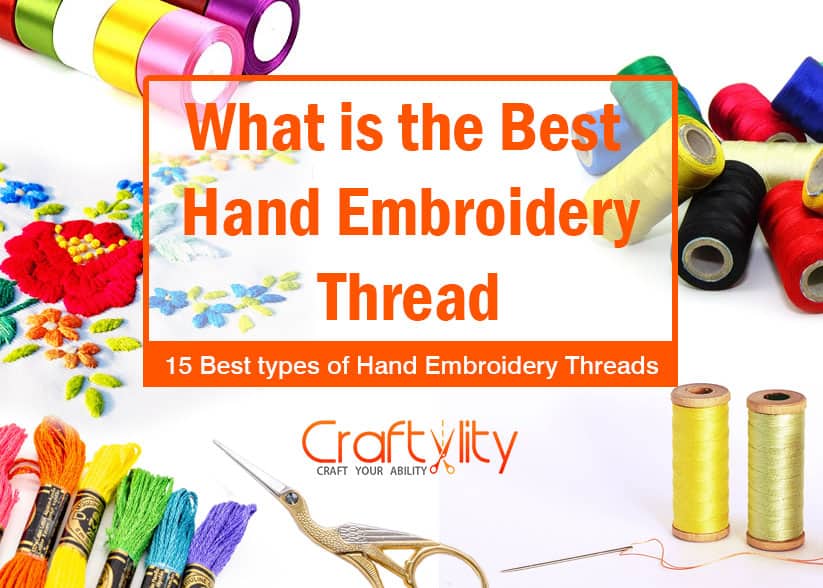
You will get multiple varieties of embroidery threads to choose from. Selecting a good embroidery thread for your upcoming project is important and it also depends upon what type of embroidery you are planning, what type of fabric you will use for the project, and also the pattern. This post will help you get an idea about different threads and also I have covered some common questions in this article to clear the confusion about threads and its texture.
Table of Contents
Best types of Hand embroidery threads
1. Cotton Embroidery Thread / Stranded Embroidery Floss
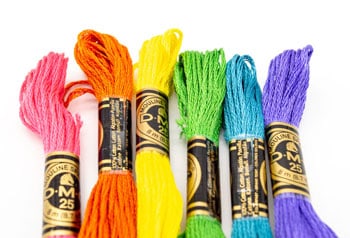
Cotton Embroidery threads are the most commonly used threads for embroidery, these are also called Stranded Embroidery thread. These threads are easily available in stores and come in a variety of colors.
Stranded threads are generally a bunch of 6 fine threads running together to form one thick thread. Each strand can be pulled apart from other strands and can also place them back together to achieve the desired thickness.
You can use all 6 strands for embroidery, like for filling flowers or leaves. If you don’t want too thick thread then you can separate the strands and use 3 instead and if you want to create a very fine and delicate design then you can use a single strand. It depends upon the design you want to create using the thread or the material you are using for the design.
Cotton thread works well on linen, cotton, and all types of cotton mixed materials. Check out the post “What Is The Best Fabric For Hand Embroidery? 6 Best Options To Choose” this post will give you an idea about different types of fabric used for hand embroidery.
Embroidery thread is the yarn that is manufactured or hand-spun specifically for embroidery and other forms of needlework. Read on Wikipedia.
2. Rayon Floss
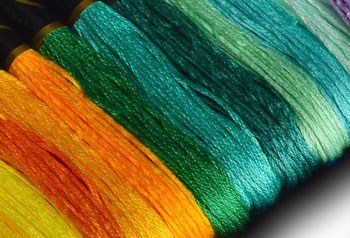
Rayon floss available in many colors same as stranded threads, but these threads are shiny like silk threads. Rayon floss can also be called artificial silk as it is a manufactured fiber that is not natural nor synthetic. Avoid using long threads as they tangle easily which makes it difficult to work with, instead use a short length. Most of the rayon floss is non-colorfast which means it can bleed when wet. It is better to do a patch test first before starting the actual design.
3. Pearl Cotton
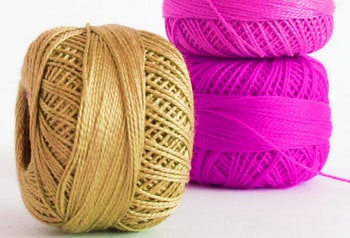
Pearl cotton is also called Perle cotton. It is 2-ply (2 strands twisted to make 1 thread), S-twisted thread which is a little heavier than the single strand of Stranded cotton thread. It is actually 2-strands twisted with a high sheen, but it is non-divisible like the cotton stranded thread. Pearl cotton threads are available in many weights, 3, 5, 8, 12, and 16, with 16 being the finest and 3 the heaviest it means the higher the number lighter the thread. It is good to use with natural fabrics like cotton and linen fabric and its texture effect is great to be used in surface embroidery, cross-stitch, redwork etc, and also crochet.
4. Metallic hand embroidery thread
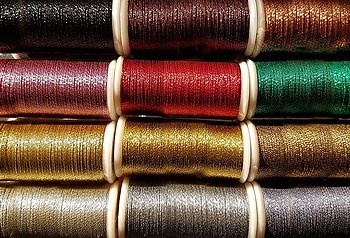
Metallic threads are generally used to add some highlights to colored embroideries. It comes in a variety of metallic embroidery threads, regular metallic floss, Twisted, braided, or woven. Each thread has its limitations and benefits. Metallic thread tangle easily while working, and they can break easily while embroidering.
Metallic thread adds charm to embroidery it can be easy to work with these threads if you know few tips which will help you to make your embroidery much easier. To avoid the thread to get tangle while working, use a shorter thread. These threads also fray while working, if it is fraying at the eye of the needle then try to use a slightly larger needle can help.
Check out “What Needle to use for Hand Embroidery“, this post will give you an idea about different types of needle and their usage.
It may be difficult to clean the fabric embroidered with metallic thread, so limit your work and clean it with caution.
5. Crewel Yarn/ Wool Thread
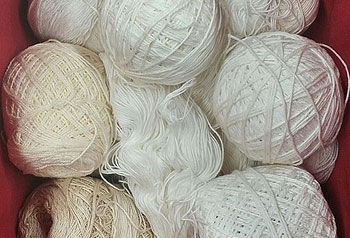
Crewel yarn is a wool-like acrylic or a fine 2-ply yarn (2 strands twisted to make 1 thread) of wool. As its name says, it is used for crewel embroidery, but you can also use this thread in different embroidery like wool embroidery, needlepoint, cross-stitch, tapestry work. It is thinner wool as compared to tapestry wool and its strands cannot be divided, unlike stranded cotton thread.
A single strand of this wool thread is as thick as two strands of cotton floss, to add some texture to your embroidery you can thread this wool thread on a needle and use it like other embroidery threads.
6. Tapestry / Persian Yarn
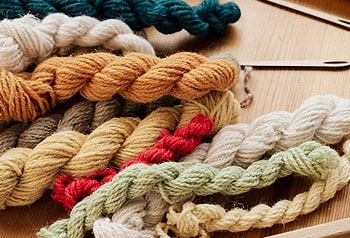
Tapestry yarn is soft and thicker than crewel yarn, it is almost like knitting wool. It is 4-ply (4 strands twisted to make 1 thread) and it is used as one strand to stitch on heavy and thick material, canvas work, or tapestry. It is also used for needlepoint projects and crewelwork.
7. Silk Threads
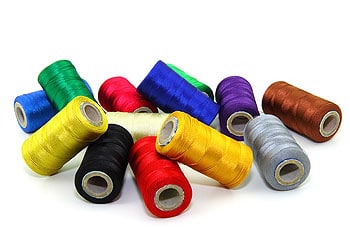
Silk threads are available in many colors and are more used in fine embroidery. It is very fine and shiny and works well in shading as its colors blend very well. It just has a small flaw that when using silk thread in embroidery work they fade very easily and they may also bleed, in spite of this flaw silk thread is a pleasant thread to work with.
8. Knitting Yarn
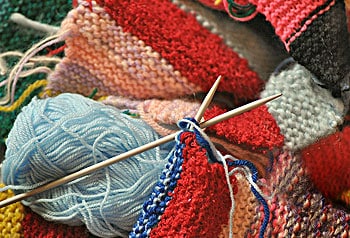
Knitting is a yarn which is available in different weight and of course, it is used for knitting.
9. Variegated threads
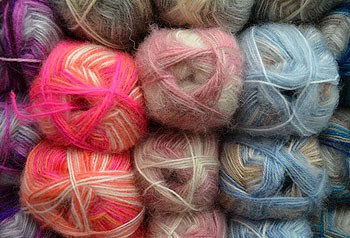
Variegated thread is the thread that has different color tones within the same thread. Variegated threads come in all the types of thread fibers like variegated pearl cotton, variegated cotton floss, variegated silk, variegated rayon, or even wool.
There are mainly two types of variegated color blends, one is tone colors and the other is contrast colors. Tone colors mean the thread will have different shades of one color, such as dark blue, medium blue, sky blue, this gives a gradient effect when stitched. Contrast colors include multiple contract shades which outstand against each shade. Variegated threads add dimension to your project and give stunning look when used correctly.
10. Sashiko thread
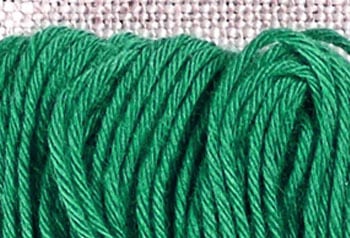
Sashiko thread is a special thread used for traditional Japanese embroidert=y work called Sashiko. It is tightly twisted heavy-weight cotton thread and as thick as 4 embroidery threads. Sashiko is an embroidery pattern created by a basic running stitch on a background. Unlike cotton embroidery thread its strands are non-dividable as it is made of fine strands tightly twisted together to make a single thread (yarn). This thread has a rough texture and does not have a shiny finish.
If you want to achieve an authentic sashiko look, you should work with sashiko threads. you can use this thread with a thin long needle with a big eye or sashiko needle.
11. Cord & Beading thread
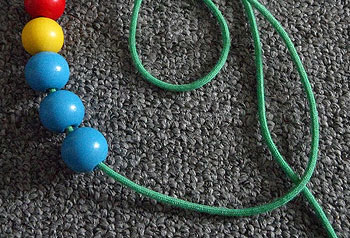
Beading embroidery is a beautiful type of embroidery in which different beads are used to attach with patterns and designs. For this, you need a strong and durable cord that holds the beads firmly. There are different types of cords available in the market, like nylon, cotton, waxed, polyester, etc.
Nylon threads are very fine and durable and can be used with very fine beads, nylon threads are available in many different colors. There are other cords like cotton waxed cord and polyester stretch cords. These are thicker cords and are used for beading stitches. You will also find Elastic twines stretch which makes them best for making beaded bracelets. Transparent cords are also used for stringing beads.
Cords are used for making jewelry, couching embroidery, crafting, knotting, lacing, and beading.
13. Crochet Thread
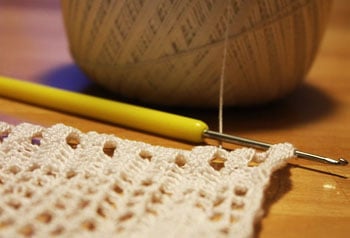
There is a wide range of yarns and threads which are used for crochet. Right from the finest to the heavest, they are available in different wights. You can use yarns, embroidery threads, pearl cotton, T-Shirt yarn, and many more.
You will need different sizes of the crochet hook to work with different crochet threads, check out “what type of crochet hook is best for beginners“.
14. Ribbons
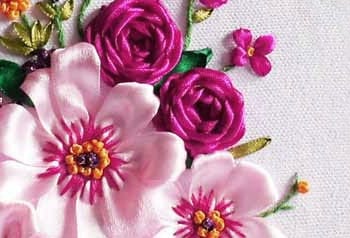
Many Ribbons are used to make gorgeous Embroidery designs. Ribbons are threaded with needles and used to create amazing designs. Ribbons come in many different colors and widths, from a narrow 1/8 inch to 1/2 inch or larger. These can be silk, cotton, or synthetic, you can select any ribbon depending on your requirements and stitch them if different patterns to create different flowers, leaves, and can be combined with other designs.
15. Floche
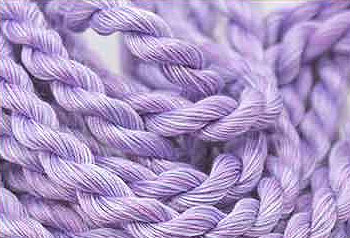
Floche is a twisted thread made from fine cotton fiber, it is 5-ply twisted together to make one non-divisible thread. It is the lightly twisted yarn that gives much better coverage than stranded cotton thread. This thread is especially suited for delicate embroidery.
What is the best thread for hand embroidery?
Generally, you can use any thread that can be threaded into a needle and pass through the fabric.
Thread selection depends upon the type of embroidery you are planning to do and the type of fabric you will use for that design.
Few Tips on selecting and using hand embroidery threads:
- First, plan the type of embroidery, pattern, and fabric you will be using in your upcoming embroidery project. Then select the type of thread which will suit that fabric and pattern.
- After selection of thread do a patch test, take a small patch of fabric, and do small embroidery on it. Try your hands on the texture and feel of the thread and also wash it after completion.
- This will give you an idea about the texture and whether the thread will bleed after a wash or not. Thus you can save your time and efforts by not making the wrong selection of thread.
- To avoid tangling of the thread while working, use a small length of thread. This will help you to work tangle-free and smoothly.
- Use Thread holders, this will help you to keep your threads organized and thus you will save lots of time.
- Use the right size of the needle for the thread, make sure that the needle doesn’t leave a visible hole on the fabric.
Try different types of threads and then select the best one for you.
I hope this post helps you to select the best thread for hand embroidery, Please let us know your thoughts and suggestions in the comment box down below.
Happy Crafting!!!

